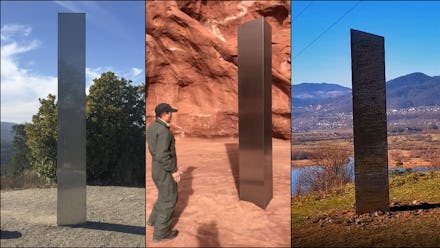The mystery of all those monoliths, unraveled

The monoliths were a fun diversion for a while. Against the backdrop of the slow, mundane hellscape of this past year, wasn’t it nice to have an extraterrestrial mystery afoot? “Wow, you guys! The aliens have landed just in time to end the coronavirus pandemic and set us on the right path to fixing climate change.” Wouldn’t that be quaint?
Obviously, the sheet metal and plywood plinths that’ve been popping up around the globe aren’t the work of aliens. If it was extraterrestrials, they’d be pretty unoriginal ones, since the appearance of the mysterious monoliths is basically a mashup of 2001: A Space Odyssey and Arrival.
Since the beginning, skeptics have speculated it was likely an artist or a brand who planted the original monolith out in the Utah desert. Government officials spotted the shiny sculpture while trying to count sheep via helicopter in the remote Red Rock Country on November 18. They announced their find on November 23, capturing the world’s imagination. Since it’s 2020, people flocked to Utah to snag a pic of the monolith for the ‘gram.
A few days later, the Utah monolith disappeared, seemingly as mysteriously as it had appeared. Then a similar monolith appeared in Romania on November 28, and local officials welcomed the arrival of their alien overlords and/or social media tourism, before it also vanished a few days later.
Meanwhile, travel photographer Ross Bernards revealed to The New York Times that he was at the site of the Utah monolith the night it was removed, November 27 — by a gang of human adventure athletes, pissed that awful clout chasers were spoiling the pristine desert landscape.
On December 2, a third monolith was discovered on a hiking trail in Southern California. The 10-foot-tall, 200 pound structure stuck around for about 24-hours before also disappearing. Turns out, the California monolith was toppled by men angry it was upstaging Jesus. "Christ is king in this country. We don't want illegal aliens from Mexico or outer space. So let's tear this bitch down, come on,” one of the men said in a video posted to a site called DLive.
By the weekend, monoliths were popping up all over the globe, and it was clear humanity wasn’t facing an imminent alien invasion — “mysterious monoliths” as a concept had simply gone viral and bled into the real world as marketing schtick. Mom and pop shops were erecting monoliths to drive business. Enterprising art collectives were also capitalizing on the craze.
After racists dismantled the Southern California monolith, four artists and fabricators came forward as the people who’d planted it there. Then they promptly installed another monolith to replace the one that’d been taken.
A different art collective, which calls itself The Most Famous Artist, started selling replica monoliths on the internet — for a cool $45,000. Apparently, they’re already sold out. A copycat took to Etsy to sell more economically priced sculptures for a mere $10,000. The Most Famous Artist folks haven’t definitively taken credit for the original monolith — doing so would be a crime — but they’re capitalizing on the publicity and letting folks believe they’re behind the stunt.
Here’s the thing: Google Earth imagery proves the Utah monolith has been there since between August 2015 and October 2016. The most tantalizing possibility is that the late artist John McCracken made it — but he died in 2011. Still, he’s known for his minimalist, silvery sculptures and affinity for sci-fi. And back in 2002, McCracken told his son he’d enjoy leaving behind an artistic treasure hunt, of sorts: “We were standing outside looking at the stars and he said something to the effect of that he would like to leave his artwork in remote places to be discovered later,” Patrick McCracken told The New York Times.
Nobody knows how a McCracken sculpture could’ve gotten to Utah after the artist’s death, however. Most likely, the desert monolith was an homage to his work by another prankster entirely, but that person hasn’t come forward yet.
Anyhow, we’ve all been spending so much time worrying about the monoliths that we’re not even talking about the other disappearing sculpture saga in the news recently: a seven-foot-tall wooden penis on a mountain in Bavaria that mysteriously disappeared — then was just as mysteriously replaced by a slightly larger wooden phallus. Humans, we’re full of surprises.